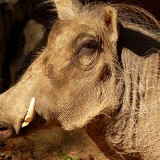RANGE
Australia, north tropical to central drier interior, and southern New Guinea.
HABITAT
Tropical to savanna scrub habitats.
SIZE
Froglet: 1/3 oz. (9.4 grams) in weight on average.
Adult: 1.8 oz. (51 grams) in weight on average.
Adult Length: to 4 inches long tip to vent.
LIFE EXPECTANCY
10 – 15 years in captivity.
DIET
Carnivorous.
Wild: Insects, baby rodents (or anything else it can catch)
Zoo: Crickets, baby mice.
BEHAVIOR
Arboreal and crepuscular.
In the dry season these frogs are often heard calling during the day from hollow limbs and trunks of large trees.
REPRODUCTION
They congregate in summer to breed in grassy, rain-filled temporary marshes.
POINTS OF INTEREST
- The genus Litoria is distinguished by horizontal pupils and large adhesive discs on the toes and fingertips. These suction discs, sticky webbing between its toes and fingers, and loose skin on the belly act as adhesive pads which enable White’s tree frogs to cling to smooth vertical surfaces.
- Extra cartilage between the last two bones of each toe allow each toe greater mobility so it can grip onto thin twigs.
- White’s tree frogs are drought resistant, having an excellent ability to retain water.
It is often found in human dwellings, in lavatories, water tanks and troughs, and downpipes. - White’s Tree Frogs have binocular vision. The nostrils and large eyes are set high on the head, so when sitting in water, the frog can breath and watch for food and predators, with the rest of its body hidden from view.
STATUS
Prolific. Not Threatened, however many are caught for the pet trade and like all amphibians they have trouble with pollution, habitat destruction and ozone depletion.







